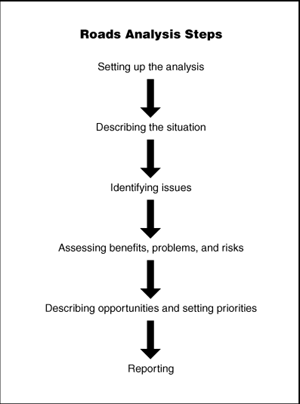
Brain Vachowski, Project Leader
Jeff Moll, Project Leader
Development of a new Forest Service Road Management Policy began in January 1998. The policy has undergone public review and is now being implemented.
The Road Management Policy seeks to:
- Use analytical tools and an interdisciplinary approach to decide when—and if—new or existing roads are needed.
- Maintain and improve roads that are needed.
- Aggressively decommission roads that are no longer needed.
Decommissioning roads means stabilizing and restoring roadway areas to a more natural state.
Within 2 years of the effective date of the Road Management Policy, each Forest Supervisor must complete a forest–scale roads analysis
A key element of the Road Management Policy directs National Forests to conduct science–based, interdisciplinary roads analyses to inform road management decisions. Informing decisions means providing information to managers to help them make sound decisions. These analyses will follow the process described in the newly revised Forest Service Manual 7700 and in the 1999 publication, Roads Analysis: Informing Decisions About Managing the National Forest Transportation System, Miscellaneous Report FS–643 (figure 1).

Figure 1—Roads analyses will be conducted according
to direction in Forest Service Manual 1920 and 7700
and guidelines in Roads Analysis, Miscellaneous
Report FS–643.
The forest–scale roads analysis is intended to answer these questions:
- Is the road system we have the system we need and can afford, both economically and ecologically?
- Is the road system consistent with what we say we are going to do in our forest plan?
At the forest scale these questions will be focused mostly on major transportation routes—generally maintenance level 3, 4, or 5 roads—determined to be of key importance for the forest.
Each analysis needs to be custom-tailored to the issues, concerns, and ecological considerations of the area being analyzed (figure 2). The interdisciplinary teams should use existing data, assessments, and plans whenever this information is adequate. The plan for the analysis should also consider how much time, effort, and money the Forest can afford to spend to analyze its road program.

Figure 2—The six steps in the roads analysis
process are
similar to steps in other types of
environmental
analyses conducted by the
Forest Service.
The findings of this forest–scale analysis may be applied either to the current forest plan or to a forest plan amendment or revision. Roads analysis includes public involvement and consultation with other Federal agencies and with State, local, and tribal governments.
Development of the roads analysis process was a collaborative effort between Forest Service Research scientists and National Forest System managers. The process is designed to provide analytical information to land managers to help them make road management decisions based on scientific principles.
The Road Management Policy has detailed interim and long–term instructions about integrating roads analysis into forest planning efforts and ongoing road management. Review the policy in Forest Service Manual 1920 and 7700 for details.
Roads analysis is not a decision-making process. The analysis provides information to managers who make decisions through the National Environmental Policy Act process.
New Video Available
To help employees understand the Road Management Policy and especially the requirement for conducting forest–scale roads analysis, the Missoula Technology and Development Center has produced a 23–minute video, A Science–Based Roads Analysis Process for the National Forests (figure 3).

Figure 3—The video, A Science-Based
Roads
Analysis
Process for the
National
Forests,
has been
sent to Forest Service
offices nationwide.
In the video, Jim Furnish, Deputy Chief for the National Forest System; Tom Mills, Pacific Northwest Research Station Director; and other members of the roads analysis team talk about how they developed the six–step roads analysis process. Afterward, employees of the Olympic National Forest describe their forest-scale roads analysis process and how they plan to use it to help make road management decisions.
This introductory program is intended for line officers, interested staff, and those who will be conducting roads analyses. Copies of the video have been mailed to all ranger districts, national forests, and regional offices nationwide.
Roads Analysis Training SessionsAnother tool to help national forests complete their roads analyses is a series of training sessions sponsored by the San Dimas Technology and Development Center. The instructors include persons who are among the most knowledgeable in the Forest Service on the topic of roads analysis. The target audience is interdisciplinary team leaders and members who will be responsible for coordinating or conducting forest–scale roads analyses.
The schedule for the training sessions includes:
| Regions 8 and 9 | February 5–7, 2001 |
| Regions 10 and 2 | February 21–23, 2001 |
| Regions 6 and 4 | February 27–March 1, 2001 |
| Regions 5 and 3 | March 6–8, 2001 |
| Region 1 | March 20–22, 2001 |
Roads Analysis Process Training Sessions
See James R. Furnish's memo to Regional Foresters, December 5, 2000 (1920/7700 Road Analysis Process Training).
Forest Service Washington Office Road Management Web Site
http://www.fs.fed.us/news/roads
Roads Analysis: Informing Decisions About Managing the National Forest Transportation System, Miscellaneous Publication FS–643
http://www.fs.fed.us/news/roads/DOCSroad-analysis.shtml
To order a printed copy:
Publication Services
Rocky Mountain Research Station
240 West Prospect Rd.
Ft. Collins, CO 80526
Fax: 970–498–1396
E-mail: rschneider@fs.fed.us
Phone: 970–498–1392 (fax or E–mail preferred)
Forest Service Roads: A Synthesis of Scientific Information
http://www.fs.fed.us/news/roads/science.pdf
A Science–Based Roads Analysis Process for the National Forests [Video]
USDA Forest Service
Missoula Technology and Development Center
5785 Hwy. 10 West
Missoula, MT 59808
Phone: 406–329–3978
Fax: 406–329–3719
E-mail:wo_mtdc_pubs@fs.fed.us
Olympic National Forest Draft Road Management Strategy Web Site
http://fsweb.f9.r6.fs.fed.us/eng/rms/index.htm
Region 2 Roads Analysis Guide
http://fsweb.r2.fs.fed.us/lmp/plan.htm
References Recommended in Roads Analysis
About the Authors…Brian Vachowski has been a Project Leader specializing in recreation, trails, and wilderness projects at MTDC since 1993. He received a bachelor's degree in forestry from the University of Massachusetts and a master's degree in outdoor recreation from Utah State University. He has worked for the Nez Perce, Bighorn, Winema, and Routt National Forests in recreation, wilderness, lands, planning, rural community assistance, special uses, fire, and timber positions.
Jeff Moll is a senior Project Leader at the San Dimas Technology and Development Center in San Dimas, CA, where he supports both the Engineering and Forest Management Programs. Jeff graduated from New Mexico State University with a bachelor's degree in civil engineering. He received a master's degree in civil engineering from Oregon State University and is a Professional Engineer. Before coming to San Dimas, Jeff worked as a preconstruction engineer on the Lincoln National Forest and as a civil engineer for timber sales access on the Kaibab National Forest.
Additional single copies of this document may be ordered from:USDA Forest Service
Missoula Technology and Development Center
5785 Hwy. 10 West
Missoula, MT 59808–9361
Phone: 406–329–3978
Fax: 406–329–3719
E-mail: wo_mtdc_pubs@fs.fed.us
Brian Vachowski
Phone: 406–329–3935
Fax: 406–329–3719
E-mail: bvachowski@fs.fed.us
Jeff Moll
Phone: 909–599–1267, ext. 246
Fax: 909–592–2309
E-mail: jmoll@fs.fed.us
http://fsweb.mtdc.wo.fs.fed.us

